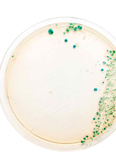
Professor Laura Piddock, deputy director of the Institute of Microbiology and Infection and Professor of Microbiology in the School of Immunity and Infection, is a leading researcher in the fight against antibiotic resistance. Her current research focuses on understanding mechanisms of antibiotic resistance as a basis for drug discovery.
When she was asked to take part in a panel discussion at the Cheltenham Literature Festival last October, Professor Piddock also gained a deeper understanding of the challenges faced by surgeons in the First World War. She was part of a discussion on Wounded, a book by medical historian Emily Mayhew which looks at injuries and infections during the War. The book tells the story of casualties and those who cared for them, and Professor Piddock described it as ‘absolutely riveting’.
The book also led Professor Piddock to look at some of the similarities and differences in bacteriology then and now – and how wartime developments inform the fight against antibiotic resistance in current times.
She said: ‘In World War One, there were no antibacterial drugs, only antiseptics such as Dakin’s solution (sodium hyperchlorite and boric acid). Alexander Fleming, whose discovery of penicillin was still some 14 years away, worked in a special wound laboratory in Boulogne, and showed that for Dakin’s solution to be most effective it had to be combined with irrigation and debridement. Recent work has suggested a re-evaluation of Dakin’s solution for treatment of wounds in combat zones could be beneficial.’
In fact, it was Fleming’s experiences in World War One which ultimately led to the discovery of penicillin as he was motivated to research ways to inhibit or kill bacteria. Professor Piddock explained: ‘He showed that traditional treatment of infected wounds with topical solutions of antiseptic was ineffective and did not prevent gangrene. He showed that this was because, firstly, white cells in pus had antibacterial activity and antiseptics damaged white blood cells, thereby reducing their ability to kill bacteria, and, secondly, cloth fragments and dirt were driven deep into the patients’ tissues causing infection which antiseptics could not reach.’
Professor Piddock also said it was interesting to note that First World War laboratories looked similar to laboratories today (other than using wooden furniture, which is not used nowadays as it has been replaced with impenetrable materials), and many of the same infection problems which existed then, persist today.
She said: ‘There were no rapid ways of identifying bacteria, and it could take between 24 hours and six weeks depending on species. However, even now, we have few rapid tools and we must firstly distinguish pathogens from commensal bacteria.’
Today, although modern medicine has moved on dramatically from the First World War, a host of other issues can complicate recovery from wound infections. Whereas, as Wounded describes, in the First World War bacteria from the farmland on which battles raged were the main cause of infections, entering the body via shrapnel wounds; nowadays, modern soldiers are more likely to suffer blast injuries into which material contaminated with bacteria is blown.
Professor Piddock said the rise of antibiotic resistance meant that the advances made since the First World War in drug development and treatment of some types of bacteria were now significantly reduced.
She said: ‘We still use many of the same technologies that Fleming used, including microscopy and culture to diagnose the pathogen in the first instance.
‘In the 21st century, the same bacterial species can also cause wound infections, but increasingly multidrug resistant Gram negative bacteria complicate recovery. There are several drugs effective against Gram positive bacteria, but increasing numbers of Gram negative bacteria infections means our therapeutic options are, to some extent, as limited as in World War One.’